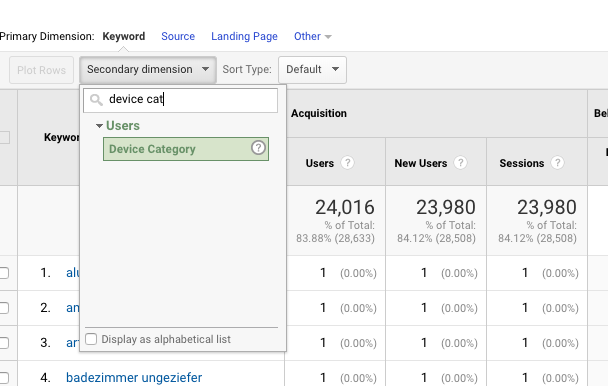Mastering Secondary Dimension in Google Analytics: A Total Overview
Mastering Secondary Dimension in Google Analytics: A Total Overview
Blog Article
Enhance Your Information Analysis Utilizing Secondary Dimension in Google Analytics
Discovering the abilities of additional dimensions in Google Analytics opens a world of opportunities for refining data analysis. The capability to explore information better past the surface level provides a nuanced sight that can shape critical choices. By layering added measurements onto primary data collections, an even more detailed story emerges, dropping light on user interactions and performance signs. This dynamic strategy to data examination holds the vital to opening surprise patterns and patterns that can change how organizations translate their digital impact.
Comprehending Second Dimensions
In the world of information evaluation, a critical aspect to understanding is the principle of additional measurements and their relevance in removing deeper insights from Google Analytics records. Additional measurements in Google Analytics describe added criteria that can be added to the main dimension, allowing for a more thorough evaluation of information. By incorporating secondary dimensions, analysts can section and filter information to reveal patterns, fads, and connections that could not be noticeable when considering the information all at once. These secondary dimensions can supply context and a more comprehensive understanding of user behavior, website traffic resources, and various other essential metrics tracked by Google Analytics.

Benefits of Making Use Of Secondary Measurements
When evaluating information in Google Analytics, the application of secondary dimensions uses important insights right into user habits and performance metrics. By including an additional dimension to your main information, you can dig deeper right into the features of your internet site visitors and their communications.
Additionally, secondary measurements assist in identifying patterns and connections that might not be immediately apparent when considering the data alone. This much deeper degree of evaluation can uncover important details that can assist advertising techniques, site optimization, and overall company decisions. In addition, second measurements enhance the context of your key information, supplying a much more thorough sight of customer involvement and efficiency metrics. Overall, making use of additional dimensions in Google Analytics can substantially boost the depth and top quality of your data evaluation, causing more informed decision-making and boosted outcomes.
Exactly How to Include Secondary Dimensions
By incorporating additional dimensions in Google Analytics, users can gain deeper understandings right into their information analysis process, permitting for more extensive analysis of individual behavior and performance metrics. Adding secondary measurements is a simple procedure that can dramatically improve the depth of evaluation. As soon as in the record, locate the "Additional dimension" tab over the information table.
Studying Data With Secondary Measurements
Making use of second dimensions in data evaluation provides an extra comprehensive understanding of customer habits and performance metrics. By adding an additional measurement to your main data established in Google Analytics, you can dive much deeper right into the characteristics of your web site site visitors and their interactions. Integrating the key dimension of 'source/medium' with the secondary measurement of 'touchdown this content page' can disclose which particular pages are drawing in website traffic from various resources, assisting you optimize these web pages for better engagement.
Fundamentally, assessing data with additional measurements empowers you to gain important understandings right into individual habits, recognize fads, and make educated choices to enhance the performance of your electronic residential or commercial properties.
Best Practices for Second Dimensions
In information analysis, integrating secondary measurements successfully can significantly enhance the depth of understandings acquired from metrics and user behavior patterns. When using second dimensions in Google Analytics or any type of other analytical device, it is vital to adhere to best techniques to make sure the accuracy and relevance of the data analysis.
One key straight from the source ideal method is to very carefully select second dimensions that enhance the main measurement being analyzed. Choosing additional measurements that give added context or additional segmentation can use an extra thorough understanding of the information. It is also vital to stay clear of overcomplicating the analysis by including as well several secondary measurements, which might bring about complication or dilution of insights.
In addition, it is recommended to try out various combinations of additional and main measurements to reveal new relationships and trends. Frequently assessing and refining the selection of additional measurements based on the certain goals of the analysis can cause more workable understandings. By complying with these ideal techniques, data experts can utilize secondary dimensions effectively to boost the general information analysis procedure and decision-making capabilities.

Conclusion
Finally, integrating secondary measurements in Google Analytics is important for a detailed information analysis approach. By leveraging additional measurements alongside primary ones, analysts and marketing experts can reveal valuable understandings and relationships that can inform decision-making and optimize digital advertising and marketing strategies. Recognizing how to efficiently utilize secondary dimensions and adhering to finest techniques will certainly permit specialists to remove meaningful data and improve their total performance metrics.
Secondary measurements in Google Analytics refer to added specifications that can be included to the main measurement, enabling for a more detailed analysis of data. By integrating second dimensions, experts can sector Visit This Link and filter information to discover patterns, trends, and relationships that might not be evident when looking at the information as a whole. Integrating the main measurement of 'source/medium' with the secondary measurement of 'touchdown web page' can disclose which certain pages are attracting website traffic from various resources, helping you maximize these web pages for better engagement.
One secret finest practice is to very carefully pick second dimensions that match the primary measurement being analyzed. By complying with these best methods, data experts can take advantage of second dimensions effectively to enhance the general information analysis process and decision-making capabilities.
Report this page